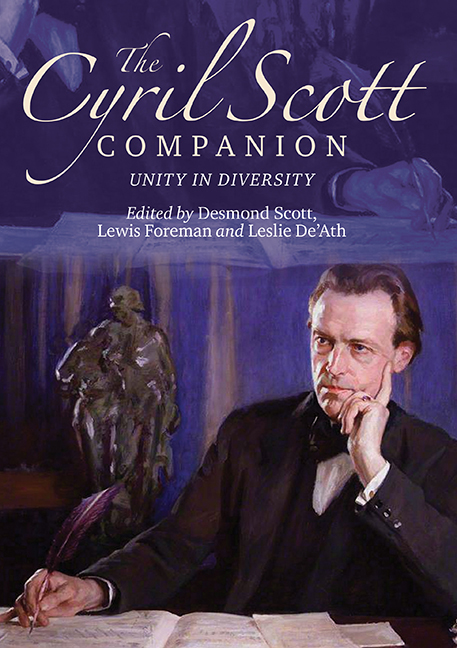Book contents
- Frontmatter
- Dedication
- Contents
- List of Illustrations
- List of Tables
- List of Contributors
- Foreword
- Preface
- Acknowledgements
- Editors' Note
- I SCOTT IN CONTEXT
- II THE MUSIC
- 8 Discovering, Editing and Recording Cyril Scott
- 9 ‘Years of Indiscretion’: The Early Piano Works, 1898–1909
- 10 ‘Like a Bird Sings’: The Piano Works from the Op. 66 Sonata to World War 1
- 11 The Later Piano Works
- 12 The Twenty-First-Century Orchestral Recordings: The Shock of the Unknown
- 13 The Chamber Music
- 14 Operas and Music for the Theatre
- 15 The Choral Works
- 16 The Songs
- III THE WRITINGS
- IV PERSONAL REMINISCENCES
- APPENDICES
- CATALOGUES, DISCOGRAPHY AND BIBLIOGRAPHY
- Index of Works
- General Index
13 - The Chamber Music
from II - THE MUSIC
Published online by Cambridge University Press: 14 September 2019
- Frontmatter
- Dedication
- Contents
- List of Illustrations
- List of Tables
- List of Contributors
- Foreword
- Preface
- Acknowledgements
- Editors' Note
- I SCOTT IN CONTEXT
- II THE MUSIC
- 8 Discovering, Editing and Recording Cyril Scott
- 9 ‘Years of Indiscretion’: The Early Piano Works, 1898–1909
- 10 ‘Like a Bird Sings’: The Piano Works from the Op. 66 Sonata to World War 1
- 11 The Later Piano Works
- 12 The Twenty-First-Century Orchestral Recordings: The Shock of the Unknown
- 13 The Chamber Music
- 14 Operas and Music for the Theatre
- 15 The Choral Works
- 16 The Songs
- III THE WRITINGS
- IV PERSONAL REMINISCENCES
- APPENDICES
- CATALOGUES, DISCOGRAPHY AND BIBLIOGRAPHY
- Index of Works
- General Index
Summary
MOST people familiar with the music of Cyril Scott – from his short piano works to his songs, symphonies and concertos – would agree that he had an extraordinary ear for what musicians call harmonic colour. By half-step alterations of certain notes in a chord, non-diatonic chord progressions, or rapid modulations to distant keys, he could create impressions on the ear that seemed comparatively brighter or darker or that had quasi-kaleidoscopic qualities that cannot be described in words, though they can be easily recognised upon recurrence.
Scott's music was valued in some circles for its harmonic colour. But in others it was denigrated for being nothing more than that. Year after year, critics chided Scott for having no sense of form or logical musical development. Few perceived that he was a revolutionary right to the end of his life, when he was occasionally berated – when noticed at all – for having nothing new to say. The nature of Scott's one-person revolution lies precisely in his lifelong struggle to reconcile expressive colour with logically unfolding form.
Scott's solution bears a resemblance to his Hungarian contemporary Béla Bartók's folk-music-derived method of polymodal chromaticism. Yet Scott arrived at his reconciliation of colour and form by an independent route – thus it merits a distinctive name. I call it pan-modality: the juxtaposition or superposition of modes to create functional equivalents for every (pan-) aspect of traditional tonal music, including melody, harmony, polyphony, tonality and form.
Scott employed modes that included five tones (pentatonic), six (hexatonic, including the whole-tone scale), seven (diatonic, including major and minor scales and the so-called Greek modes encountered in Gregorian chant and folk music), eight (octatonic, including the symmetrical scale of alternating whole- and halftones), and possibly more, up to twelve (the chromatic scale – but generally not a twelve-tone row as used in the dodecaphonic school of composition). Such modes could be simple (such as those listed above), exotic (as in Indian rāgas), or synthetic (self-created by the composer, often through chromatic alteration of a simple mode or by non-tonal doubling of melodic lines in major thirds, perfect fourths, and so on).
- Type
- Chapter
- Information
- The Cyril Scott CompanionUnity in Diversity, pp. 189 - 204Publisher: Boydell & BrewerPrint publication year: 2018



